

Continuous Improvement Model. The Continuous Improvement Model can be summarized as follows: Review – The effort from preliminary information gathering through detailed testing and summarization of results.
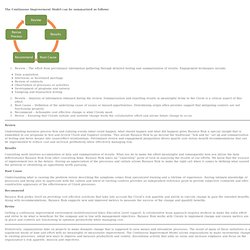
Engagement techniques include: Data acquisition Interviews or facilitated meetings Review of contracts Observation of processes or activities Development of programs and surveys Sampling and transaction testing Results – Analysis of information obtained during the review. Summarization and reporting results in meaningful terms to the Client is a critical aspect of this effort. Root Cause – Definition of the underlying cause of issues or missed opportunities. Determining origin often provides support that mitigating controls are not functioning properly. E-learning. Use of technology in education to improve learning and teaching Educational technology (commonly abbreviated as EduTech, or EdTech) is the combined use of computer hardware, software, and educational theory and practice to facilitate learning.[1] When referred to with its abbreviation, EdTech, it is often referring to the industry of companies that create educational technology.[2][3] Definition[edit] Accordingly, there are several discrete aspects to describing the intellectual and technical development of educational technology: Educational technology as the theory and practice of educational approaches to learning.Educational technology as technological tools and media, for instance massive online courses, that assist in the communication of knowledge, and its development and exchange.

Curriculum. In formal education, a curriculum (/kəˈrɪkjʉləm/; plural: curricula /kəˈrɪkjʉlə/ or curriculums) is the planned interaction of pupils with instructional content, materials, resources, and processes for evaluating the attainment of educational objectives.
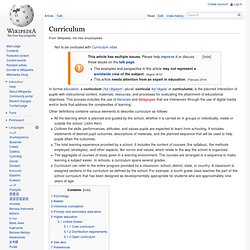
This process includes the use of literacies and datagogies that are interwoven through the use of digital media and/or texts that address the complexities of learning. Other definitions combine various elements to describe curriculum as follows: All the learning which is planned and guided by the school, whether it is carried on in groups or individually, inside or outside the school. Fine Arts. Fine art, from the 17th century on, has meant art forms developed primarily for aesthetics, distinguishing them from applied arts that also have to serve some practical function.
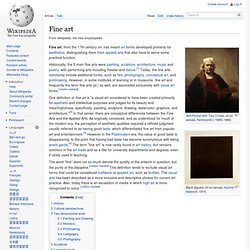
Historically, the 5 main fine arts were painting, sculpture, architecture, music and poetry, with performing arts including theater and dance.[1] Today, the fine arts commonly include additional forms, such as film, photography, conceptual art, and printmaking. However, in some institutes of learning or in museums, fine art and frequently the term fine arts (pl.) as well, are associated exclusively with visual art forms. [citation needed] The word "fine" does not so much denote the quality of the artwork in question, but the purity of the discipline. Video Game. A video game is an electronic game that involves human interaction with a user interface to generate visual feedback on a video device.
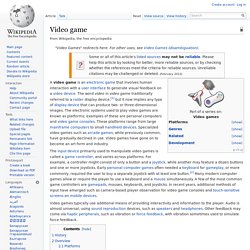
The word video in video game traditionally referred to a raster display device,[1] but it now implies any type of display device that can produce two- or three-dimensional images. The electronic systems used to play video games are known as platforms; examples of these are personal computers and video game consoles. These platforms range from large mainframe computers to small handheld devices. Specialized video games such as arcade games, while previously common, have gradually declined in use. Video games have gone on to become an art form and industry. Video games typically use additional means of providing interactivity and information to the player. History Early games used interactive electronic devices with various display formats. Other early examples include: Overview Platforms Genres Classifications Casual games Main article: Casual game Serious games.
Photography. For the image obtained, see Photograph.
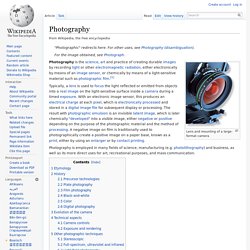
Lens and mounting of a large-format camera Photography is the science, art and practice of creating durable images by recording light or other electromagnetic radiation, either electronically by means of an image sensor, or chemically by means of a light-sensitive material such as photographic film.[1] Photography is employed in many fields of science, manufacturing (e.g. photolithography) and business, as well as its more direct uses for art, recreational purposes, and mass communication.
Etymology[edit] The word "photography" was created from the Greek roots φωτός (phōtos), genitive of φῶς (phōs), "light"[2] and γραφή (graphé) "representation by means of lines" or "drawing",[3] together meaning "drawing with light". Comics. Fine art, from the 17th century on, has meant art forms developed primarily for aesthetics, distinguishing them from applied arts that also have to serve some practical function.

Historically, the 5 main fine arts were painting, sculpture, architecture, music and poetry, with performing arts including theater and dance.[1] Today, the fine arts commonly include additional forms, such as film, photography, conceptual art, and printmaking. However, in some institutes of learning or in museums, fine art and frequently the term fine arts (pl.) as well, are associated exclusively with visual art forms. Theatre. Theatre or theater[1] is a collaborative form of fine art that uses live performers to present the experience of a real or imagined event before a live audience in a specific place.
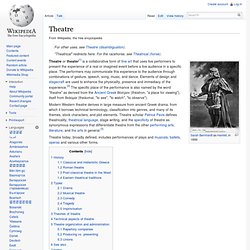
The performers may communicate this experience to the audience through combinations of gesture, speech, song, music, and dance. Elements of design and stagecraft are used to enhance the physicality, presence and immediacy of the experience.[2] The specific place of the performance is also named by the word "theatre" as derived from the Ancient Greek θέατρον (théatron, "a place for viewing"), itself from θεάομαι (theáomai, "to see", "to watch", "to observe").
Modern Western theatre derives in large measure from ancient Greek drama, from which it borrows technical terminology, classification into genres, and many of its themes, stock characters, and plot elements. Dance. Origins and history Many contemporary dance forms can be traced back to historical, traditional, ceremonial, and ethnic dance.
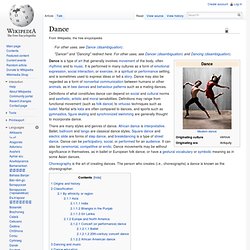
For example, some Sri Lankan dances are related to aboriginal, mythical devils known as "yakkas", and according to local legend, Kandyan dance began as a ritual that broke the magic spell on a bewitched king. Illustration. Illustrations are often carried out as a large-scale industrial process, and is an essential part of publishing and transaction printing.

People strolling by the banks of the River Thames. Illustration beats explanation. Western Engraving & Colortype Co. History[edit] Medieval codices' illustrations were called illuminations. Painting. Music. This article is about music as a form of art. For history see articles for History of music and Music history. Small Learning Community. A Small Learning Community (SLC), also referred to as a School-Within-A-School, is a form of school structure that is increasingly common in American secondary schools to subdivide large school populations into smaller, autonomous groups of students and teachers. The primary purpose of restructuring secondary schools into SLCs is to create a more personalized learning environment to better meet the needs of students.
Each community will often share the same teachers and student members from grade to grade. Teachers in these units usually have common planning time to allow them to develop interdisciplinary projects and keep up with the progress of their shared students. Types[edit] SLCs can take several forms. Theme-Based Smaller Learning Communities or Focus Schools are usually formed around a specific curricular theme.
Facilitator. A facilitator is someone who helps a group of people understand their common objectives and assists them to plan to achieve them without taking a particular position in the discussion. Some facilitator tools will try to assist the group in achieving a consensus on any disagreements that preexist or emerge in the meeting so that it has a strong basis for future action. Definitions[edit] Student. Pupils in rural Sudan, 2002 International variations[edit] Asia[edit] Brunei[edit] Education is free in Brunei Darussalam not limited to government educational institutions but private educational institutions too.
There are mainly two types of educational institutions namely government or public as well as private institutions. Mentorship. Attachment theory. Learning Community. Professional Learning Community. A professional learning community (PLC) is an extended learning opportunity to foster collaborative learning among colleagues within a particular work environment or field. It is often used in schools as a way to organize teachers into working groups. Definitions[edit] PLCs have many variations. In one definition PLCs "extend... classroom practice into the community; bringing community personnel into the school to enhance the curriculum and learning tasks for students; or engaging students, teachers, and administrators simultaneously in learning.
The idea behind a PLC was to integrate two concepts that in the past, have been quite distinctive from each other; professional and community. Staff development[edit] Barriers to implementation[edit] In the book Intentional Interruption: Breaking Down Learning Barriers to Professional Practice, Dr. Because of these difficulties many teachers are turning to the internet for PLCs. Education. Teacher. Jewish children with their teacher in Samarkand, the beginning of the 20th century A teacher (also called a schoolteacher) is a person who provides education for pupils (children) and students (adults).
Cooperative Grouping. What works and what doesn't.